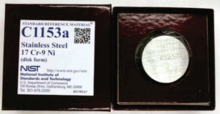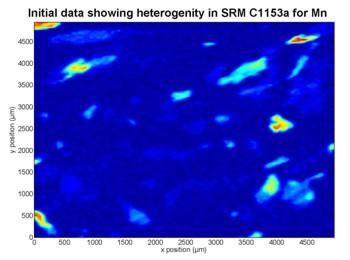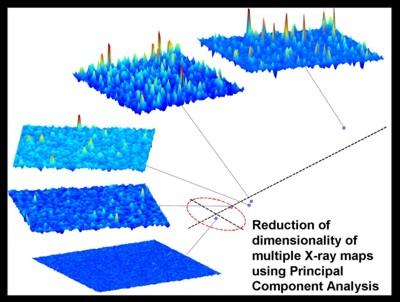Summary

Microbeam X-ray fluorescence (µXRF) has been used nondestructively to investigate elemental heterogeneity by constructing two-dimensional maps of elemental concentrations in reference materials. µXRF probes sample sizes well below the 100 mg minimum mass NIST usually recommends for measurement of elements in reference materials. Multivariate methods of analysis such as principal-component analysis (PCA) show promise in identifying whether "nugget" effects exist, in which an element is enriched in small, isolated areas of the sample. The PCA model is built based on data taken in one location and compared with each elemental map. A method of calculating the minimum recommended mass for solid samples is suggested using PCA iteratively on X-ray maps from which adjacent data points have been averaged.
Description

Initial data showing heterogeneity in SRM C1153 for manganese, using microbeam X-ray fluorescence spectroscopy.
Presently there are a variety of analytical techniques that are served by few or no reference materials due to the small sample sizes they require. NIST currently certifies solid reference materials at or above the 100 mg mass level in most cases with no mention of the effect of using smaller sample sizes. The intent of this project is to develop a method to characterize heterogeneity at lower mass levels, extending current SRMs to the mass regimes of a number of techniques and allowing future SRMs to be relevant to a wider variety of customers.
Major Accomplishments
- Developed methodology and software to aid heterogeneity assessment of large sets of data from µXRF
- Developed methodology using principle component analysis to determine minimum recommended sample size
Additional Technical Details
Existing research performed by other authors suggests that complex data analysis techniques like Monte Carlo modeling can be used in conjunction with µXRF to estimate elemental heterogeneity on a microscale. Equally sophisticated methods of analysis, such as principal component analysis (PCA), show promise in describing complex data patterns arising from various samples. Each element must be statistically treated according to its level of heterogeneity within the sample. Samples must be separated into elements with nugget effects, heterogeneous elements that do not exhibit nuggets, and homogeneous elements, with a different statistical treatment used in each case. Data from the first group conforms to a wide variety of distributions only adequately described by nonparametric statistical methods, while the second two groups can be adequately summarized using more common statistical methods, which assume normally distributed data. The intended result of these different treatments is a standard method for calculating the minimum recommended sample size of each reference material. However, the complexity of many reference materials and tendency of higher atomic number elements to affect the signals of low atomic number elements makes modeling such systems nontrivial.
In addition to µXRF, instrumental neutron activation analysis (INAA) is able to measure small samples of material in the range of 1 mg to 100 mg. INAA gives complementary information to µXRF because the more penetrating radiation is able to thoroughly probe thicker samples containing many heavy elements. Because its sources of uncertainty are very well characterized, INAA can also identify inconsistencies such as sample changes from preparation for analysis, and it offers a different picture of each sample, giving more information on which to build a descriptive model of a reference material. INAA bridges the gap between current, bulk analysis methods and methods developed using µXRF, confirming models constructed of heterogeneous samples.

ASSOCIATED PUBLICATION
Molloy, J.L., Sieber, J.R., Classification of Microheterogeneity in Solid Samples, Anal. Bioanal. Chem. 392:995-1001 (2008).

